Having difficulty in choosing your firearm cleaning kit? Then this is the article for you. In this article, I’ll discuss what each tool of the gun cleaning kit is used for, and then you can choose the best gun cleaning kit for yourself, by yourself. “Gun Cleaning Tools Explained” is kind of clickbait.
Whether it is for your handgun, rifle, shotgun, or all of them. All types of gun cleaning tools must have these components. And as a new gun enthusiast, you must understand the tools you are going to use to clean your gun.
I won’t be talking about how to clean your gun so I’ll skip over that and the safety-related to that topic.
Essential Gun Cleaning Tools.
The list of the explained tools is listed below;
I can bet you won’t get all these essential tools in any reloading kit. Which means you will need to buy some tools individually. Some of the tools do have alternatives but you will still need one of those alternatives. To have everything arranged, I suggest buying a cleaning kit because when you buy a kit all these come in a tightly arranged compact box, which is easy to carry around or store.
1. Gun Cleaning mat.
The cleaning process involves cleaning liquid, carbon residues, and dust. And to make things faster, easier, and cleaner I use a cleaning mat, making it easier to clean the working space. You don’t have to stick with a cleaning mat, you can use newspaper, rolls of tissue, or a towel. Basically, it is something to cover up and protract the table surface from the cleaning solvent and gun oil. The one shown here has printed instructions on how to disassemble and clean Glock handguns.
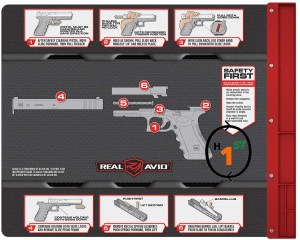
If your table is made of wood or metal, I would suggest taking precautions to avoid touching the cleaning solvent with it. Because the cleaning solvent will definitely ruin the looks of the table.
2. Gun Vise
Imagine you are cleaning a rifle and then you have to hold the rifle with 2 hands, position the cleaning tools so that you can easily insert it into the barrel with one hand, and then push the cleaning rod inside the barrel.
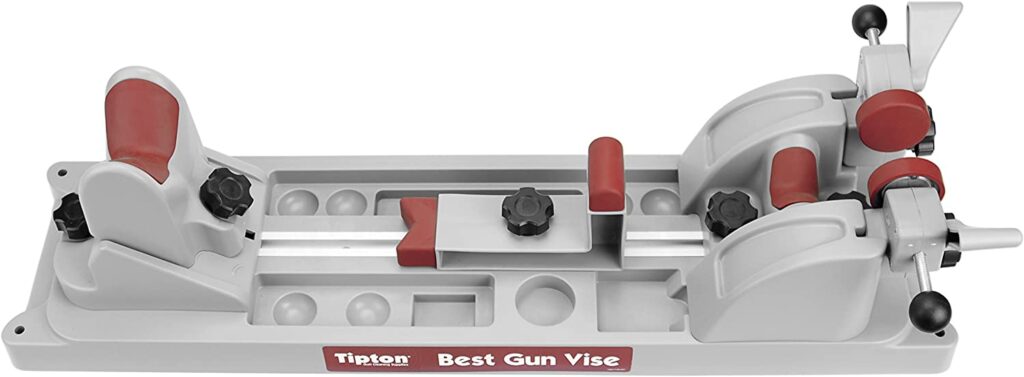
But there is a major problem with that! We humans only have 2 hands! Either you hold the gun or clean it, and I prefer cleaning the gun and let my “Gun Vise” hold the rifle. Gun vise do just that – Holds your gun in position.
Bore Cleaning Accessories
Cleaning the barrel of the gun is the most time-consuming task, and it requires 6 different tools alone to get satisfactory results.
3. Bore Access Tools.
There are 3 tools that allow access inside the bore. A Cleaning Rod, Flex Cable, and Bore Snake. And with their unique advantages, they shine best in different circumstances.
A barrel cleaning rod can be made of brass, aluminum, carbon fiber, or wood, and all these materials are tough enough to take the applied pressure but weaker than steel or iron to avoid scratching or harming the barrel. These cleaning rods usually screw in together to extend to the desired barrel length. The cleaning rod has a handle on one end and screw in thread on the other for cotton mop, bronze bore brush, or jags screws on. It’s the most convenient way to scrub the insides of the barrel because you can push and pull while cleaning the barrel.

The flex cable does the same thing except you can only pull the attachments instead of pushing them inside the barrel. With a flex cable, you can clean or lube the inside of the barrel without disassembling the firearm. As the name suggests, it’s a flexible cable that can be bent for storage requiring less space.
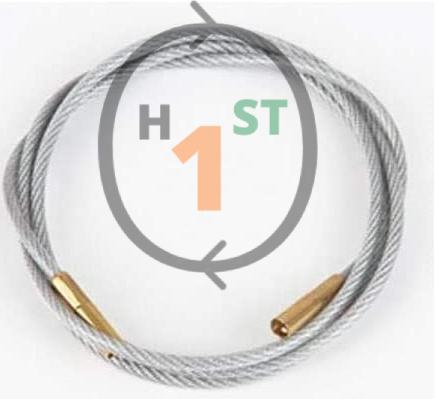
The bore snake is unique because it applies lubricant, scrubs, and cleaning in just one pull action. It consists of a brass weight with a cord attached to it to allow it to easily pass through the barrel, then a cloth section where you can apply the cleaning solution to moisten the gunk buildup inside the barrel, following that bronze bore brush to scrub the inside of the barrel and loosen the gunk, and finally another long cloth section to clean up the inside of the barrel.
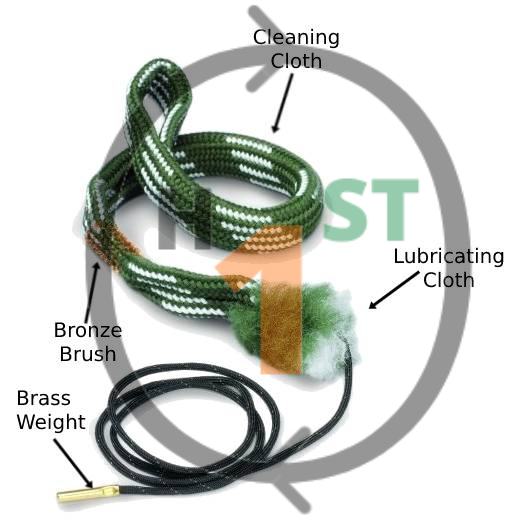
The bore snake performs 4 tasks in one sweep. It lubricates the barrel (replaces bore mops), scrubs it using the bronze bore brushes (replaces brushes), cleans the barrel (replaces patches), and lubricates (replaces more patches). It helps with a quick clean but not a shiny clean. And since it’s made of cloth It’s portable and easily storable.
| Brass Rod |
|---|
| Best in bore cleaning. |
| Takes a moderate amount of time. |
| Need attachments |
| Not so portable |
| Flex Cable |
|---|
| Moderate rate of cleaning. |
| Takes the most amount of time. |
| Need attachments |
| Portable |
| Bore Snake |
|---|
| Quick clean, but not perfect. |
| Takes the least amount of time. |
| No need for attachments |
| Highly portable. |
The bore accessing tools have their unique situations best suited for their particular situation. The difference between them has been tabulated above for easier comparison. This tool preference varies from person to person. And in my case, I use all 3 types but the situation varies. In a competition, I quickly clean my barrel after each round using the bore snake, and I carry the flex cable while going for hunting or cleaning in a range without disassembling my firearm. But when I’m at home, I usually clean my guns with brass rods as it gives the best cleaning but it takes time.
4. Muzzle Guard
Never clean your gun from the muzzle end as it damages the crown of the gun and reduces accuracy. But if you must clean from the muzzle end of the gun then definitely protect your crown using a muzzle guard also known as bore guide. It will take all the pressure of the wavering hand while inserting, pushing & pulling the cleaning rod through the bore. If you haven’t noticed, this tool is only for the cleaning rod.

5. Cotton bore mops.
Cotton mops are just as the name suggests, cylindrical-shaped patches of cotton to mop the inside of the bore. It can be used for applying solvent inside the barrel or clean up after the cleaning solvent has been used. The Cotton Bore Mops are washable so you can use them as long as they have a relatively tight fit.
I usually use them for applying cleaning solvent only, as this increases its lifetime, and requires less washing.

6. Cleaning Solvent.
A cleaning solvent is a liquid that loosens the carbon buildup in the bore surface when a firearm is used. Many manufacturers make cleaning solvent, but I prefer Hoppe’s 9 because it does a better job at loosening the carbon buildup.
There is some cleaning solvent that evaporates, leaving no residue, this type is usually used for magazine cleaning.
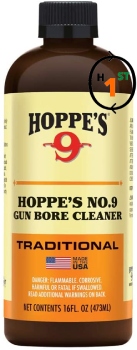
7. Phosphor Bronze Bore Brushes
This type of brush has hard phosphor bronze bristles to clear up the bigger carbon residue inside the barrel that was soaked in by the cleaning solvent using a cotton bore mop. These bronze brushes are caliber specific which means you can’t use .45 calibers’ brush for .38 or vice versa.

A good bronze bore brush should have a higher bristles density to remove the carbon residue that is inside the grooves of the rifle or handgun. The bristles will wear out as you keep using them and eventually you will need to replace them. But that takes time.
8. Payne Galway
This is just like the bronze bore brush but this bore cleaner is meant for mostly shotguns. It has more bristles and cleans more effectively than bronze bore brushes.
9. Jags / Slotted Tips
After scrubbing the bigger dirt and carbon residue, do you think it’s clean enough? If the answer is yes then my friend you may be hurting your firearm. Coz there are still powdered dust and carbon left in the barrel and to clean these powdered dust you will need jags or slotted tips.
Jags and slotted tips are not the same tools. A Jag is a caliber-specific tool that has a tight-fitting inside the barrel when used in conjunction with a cotton patch. Whereas slotted tips use cotton patches to achieve that tight fit. With jags, you can use any cotton patch only 2 times but with a slotted tip, you can use the Otis Technology cotton patches up to 6 times. Jags can’t replace cotton bore mops, but slotted tips can be used instead of cotton bore mops.
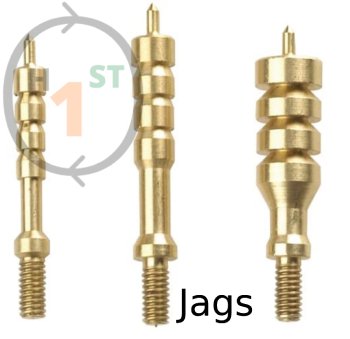
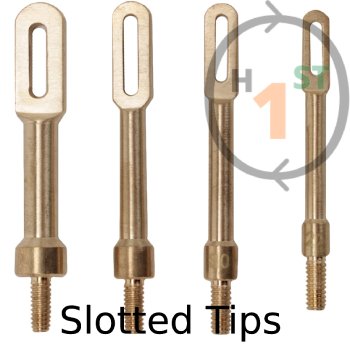
In the marketplace, you have nylon and brass Jags. I prefer brass Jags because they go through some pressure and nylon jags tend to bend and break.
I have not seen slotted tips of nylon, only brass once, and they can take the pressure.
10. Cotton Patches
Soft cotton pieces of cloths for final cleaning in the barrel. Cotton patches come in circular and rectangular shapes. The rectangular one can be used twice hence takes up more storage space. Whereas the circular cotton patches by Otis Technology can be used up to 6 times. And depending on the size of the barrel you can use up 10-20 cleaning patches in one cleaning.
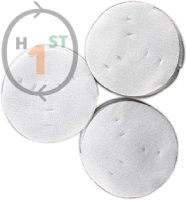
Some opt to use tissue paper and that is perfectly fine, just make sure there is not even a single grain of sand inside the bore and on the tissue. Because that will scratch the bore while cleaning with tissue. It’s the same principle as that of your “Corning Gorilla Glass”, you should always use a microfiber cloth to clean.
In my Honest Opinion, Otis Technology patches are more cost-effective when used with a slotted tip.
11. Chamber Light
Some call this tool Bore Light and have few other names. It basically just a light source that bends and illuminates the chamber from the breech end to enable viewing the inside of the barrel from the muzzle end. And helps in judging whether it requires more cleaning. Stay away from those $100+ chamber lights. In my opinion, buy a bore light make a budget of $25 maximum.

12. All-Purpose Brush
This is just a toothbrush with a fancy name. But this is the tool you use for cleaning the frame, slide, and slide rails. And this is the tool that you will need to replace the most because the bristle will break, bend or simply wear out. You can buy a specifically made All-purpose (AP) brush for your firearm which is a bit expensive. The bristles can be nylon, bronze, or stainless steel. If you are going to buy a nylon cleaning brush, make sure it has white bristles.
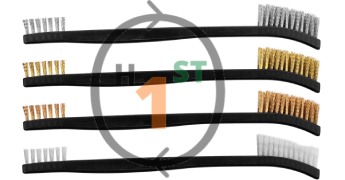
The common choice of bristle materials is either nylon or bronze, but there are brass and steel brushes as well. Nylon is for frames made of polymer and bronze is for iron frames. I would advise not to use a bronze brush on a polymer frame but you can use a nylon brush on an iron frame.
The AP Brush is the one you would use the most, I keep at least 3 in my cleaning kit because sometimes one simply gets dirty too quickly.
13. Straight and Bent Pick
As the name suggests it is a metal pick used to reach those narrow spaces where you can’t reach with your fingers and patches. The main use of this tool is to remove the tough dirt buildup in the narrow spaces.

I use a brass pick because steel picks can scratch your firearm and begin the resting process. Where as plastic pick will break or wear out faster.
14. Q-tips
Nothing special just your regular cotton swabs, for those spaces where you can’t reach with your finger and you just used your pick to remove the dirt. The Q-tips can be used with cleaning solvent or dry depending on the use and firearm part.
There are round and conical Q-tips in the market but they don’t make a difference and cost the same. So try and find out which style suits you best.
15. Gun Lubricant
Gun Oil or any other type of lubricant is used for lubricating the slide and barrel which has metal contact and is prone to wear out over time. There are manufacturers out there, but I prefer Hoppe’s needle head Lubricating oil. The needle head helps in applying the lubricating oil. Don’t buy a huge amount of oil, because, for a handgun, you only need a few drops.

16. Storing Kit
All these tools can be put in a box and carried around, but is harder to get access to when the tools are not arranged in a box. To avoid that problem, many manufacturers have compiled these tools in a bag or case that sorts and has a specific area cut out with thigh fittings, so you can easily access them at a glance.
This toolbox or cleaning kit best shines during those hunting journeys. Where you have to keep everything in place and not damage the cleaning tools. The one shown here is a 9mm Cleaning kit by Otis Technology
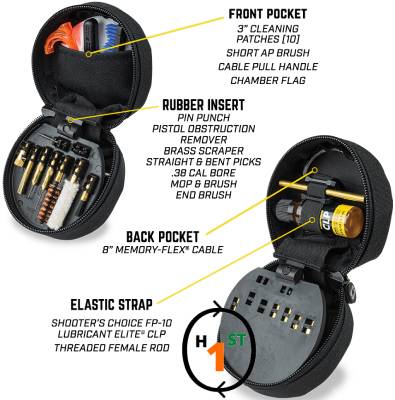
Every Gun Cleaning Tools Explained! Have I got all?
Definitely Not. But I have covered most of the important equipment here. Even then you won’t need all the tools that are mentioned here to clean your firearm. And I strongly suggest getting a gun cleaning kit that has most of the tools you will need. Always make sure that you can store your cleaning solvent and gun oil in the case, to have a ready package on the go.
There are endless tools in the market but these are the must-have tools, trusted by most reloaders if not all. And there are lots and lots of cleaning kits in the market, and it can get overwhelming when you have to decide which is best for your gun. I’m currently experimenting with many cleaning kits and when I finish that I will put up a link here. I’ll have articles to help you choose the best handgun cleaning kit, rifle cleaning kit, and universal cleaning kit that cleans both rifle and handgun.
Please note that if you use only one firearm then it’s better to have a single cleaning kit for that specific firearm only because you would get most of the tools specific for that caliber.
And 9mm being a popular choice and also my daily carry I have already put up an article reviewing the products I have used and selecting the best cleaning kit for 9mm within in my small arsenal.
But if you have multiple guns of multiple types of calibers then you need a cleaning kit that can clean all types of firearms. And for that check out my universal gun cleaning kit list.
I honestly hope I was able to help you get a better understanding of the tools and their use.
